Gamification Loyalty Programs: Google Local Guides is the G.O.A.T
Google Local Guides may not come to mind as a Gamification Loyalty Program, in fact most consumers aren’t even...
Points Rewards programs are certainly a popular form of loyalty program, but it's important to remember that there are numerous loyalty program designs that don’t include points at all. In fact, there are 7 distinct types of loyalty programs to consider when revamping a loyalty program or starting a brand new one. A sound loyalty program design process will start with your objectives and the unique opportunities that exist for your brand, and only then move to program concepts that are best aligned. Although you’ll want to mix and match to achieve a balanced program design, these 7 different loyalty program types provide a good starting point for brainstorming and ideation.
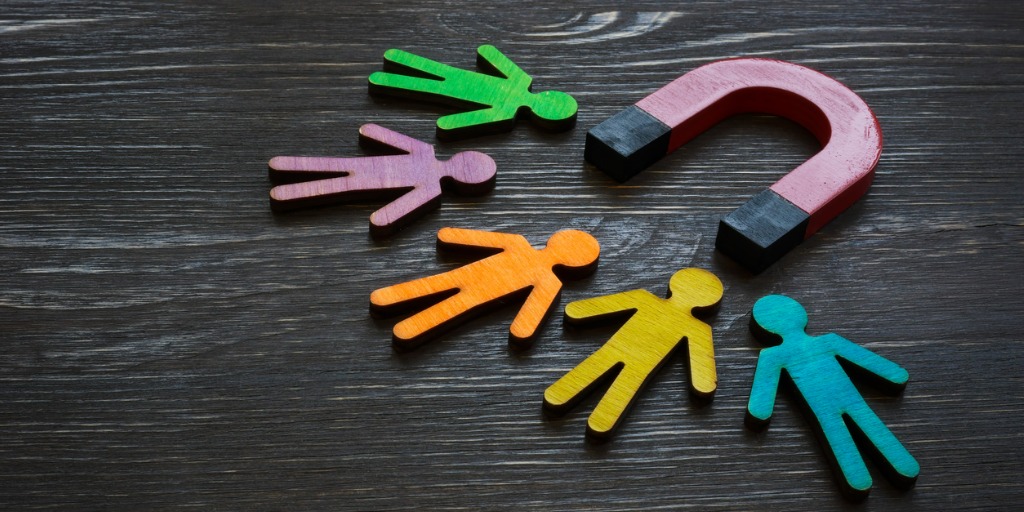
Let’s begin with Point Rewards Programs, the place it all started and a foundational piece to many loyalty programs. This type of loyalty program is scientifically designed to nudge member behavior along using points and point bonuses. By setting rewards at the right levels, you can generate incremental usage and a much higher ROI than traditional discount programs. To be effective, points programs must be simple and provide immediate value because typically more than 50% of those who join a points program use it just once and never return.![]()
The key to success with a Points Rewards Program is establishing the value up front, and integrating the points program into the overall brand experience vs treating it as a separate promotional silo. The MyMcDonald’s Rewards program shows how a well design points program can rapidly become a pillar of the brand proposition, replacing much more expensive, non-targeted promotions. See our detailed review of this program.
Loyalty Program Partnerships are closely associated with Points Rewards Programs, but seek to increase the relevance and engagement by broadening earning or other benefit opportunities. Coalitions of complementary brands band together to cost effectively achieve increased scale.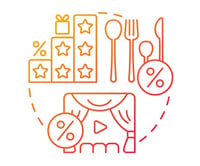 To be effective, the partnership brands must be relevant -- experience has proven that consumers quickly lose interest in vast networks of unrelated partners. Joining an existing partnership can be a good opportunity for a smaller brand that may not have a high enough purchase frequency for a stand-alone program. As an anchor brand, bringing on numerous smaller partners can help combat larger competitors and/or defray program. Loyalty Program See our reviews of partnerships such as United Airlines, or the new Delta/Starbuck’s partnership, for strong examples of best practices.
To be effective, the partnership brands must be relevant -- experience has proven that consumers quickly lose interest in vast networks of unrelated partners. Joining an existing partnership can be a good opportunity for a smaller brand that may not have a high enough purchase frequency for a stand-alone program. As an anchor brand, bringing on numerous smaller partners can help combat larger competitors and/or defray program. Loyalty Program See our reviews of partnerships such as United Airlines, or the new Delta/Starbuck’s partnership, for strong examples of best practices.
A key component of a loyalty program is the value exchange, and this is where CRM Loyalty Programs live, at the intersection of permission/engagement and “benefits”. Benefits can include a wide range of offerings, including more tangible benefits like discounts, as well as softer benefits like access to special events, priority treatment, and personalized communications. Registering for the program can also improve the experience by speeding transactions, keeping purchase history and tracking warranties. 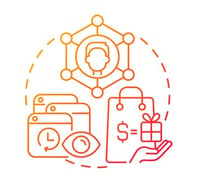 CRM Loyalty Programs trade heavily on strong brand equity as well as their ability to make an already positive experience just a little bit better. IKEA Family, one of the world’s largest programs, has achieved success with a relatively modest set of benefits, including a 5% discount on in-store purchases. As a result, IKEA can now identify over 150MM of their customers worldwide, and this data fuels a wide array of relevant CRM communications. Please see our review of IKEA Family for more information.
CRM Loyalty Programs trade heavily on strong brand equity as well as their ability to make an already positive experience just a little bit better. IKEA Family, one of the world’s largest programs, has achieved success with a relatively modest set of benefits, including a 5% discount on in-store purchases. As a result, IKEA can now identify over 150MM of their customers worldwide, and this data fuels a wide array of relevant CRM communications. Please see our review of IKEA Family for more information.
Converting traditional transactions to recurring purchase subscriptions is a major trend, and a Loyalty Program design approach has played a key role. Subscription Loyalty Programs can mix points, recognition or other special perks into the subscription package, creating a hybrid Subscription Loyalty Program. The end goal is maximizing retention and customer lifetime value, and adding in loyalty benefits can make a strong addition to the value proposition.
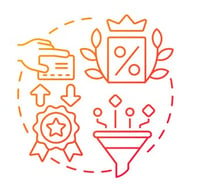 The Subscription Loyalty Program approach is hitting many verticals, from pet supplies to shave clubs, wine clubs and ski passes not to mention streaming services, cell phones and sports tickets. Players like Naked Wines have taken innovation to a new level, and built their entire product around loyalty, including strong community and gamification elements. Meanwhile in the alpine ski industry, the Ikon and Epic Pass offerings have forged massive partnerships that compete for member spend across the globe each winter.
The Subscription Loyalty Program approach is hitting many verticals, from pet supplies to shave clubs, wine clubs and ski passes not to mention streaming services, cell phones and sports tickets. Players like Naked Wines have taken innovation to a new level, and built their entire product around loyalty, including strong community and gamification elements. Meanwhile in the alpine ski industry, the Ikon and Epic Pass offerings have forged massive partnerships that compete for member spend across the globe each winter.
Personalized Loyalty Programs rely on highly personalized rewards or offers as compared to one size fits all programs. Taking a page out of the airline’s yield management book, incentives are custom designed based on algorithms and business rules. While technically challenging, this approach can deliver a much higher ROI because of the advanced targeting and test/learn approach.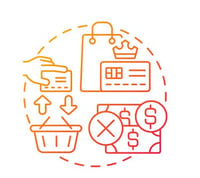 7-Eleven’s 7Rewards program provides a compelling success story. Launched just a few years ago, 7Rewards has vaulted onto the loyalty scene with dynamic incentives targeting the most relevant categories and products for each individual member. This level of personalization keeps members constantly wondering what’s next, and creates high program engagement. Please see our review of the 7Rewards program for some thought starters.
7-Eleven’s 7Rewards program provides a compelling success story. Launched just a few years ago, 7Rewards has vaulted onto the loyalty scene with dynamic incentives targeting the most relevant categories and products for each individual member. This level of personalization keeps members constantly wondering what’s next, and creates high program engagement. Please see our review of the 7Rewards program for some thought starters.
While Tiered Loyalty Programs have been around for years, this program type has ventured far beyond simple VIP benefits into the experiential realm, enabling brands to create amazing experiences for the limited audiences of their very best customers. Tiered programs allocate the most special benefits to customers with the highest spend, usage or other key metrics. These small groups are extremely high value, often spending 5 - 10X more than the customers in the bottom tier.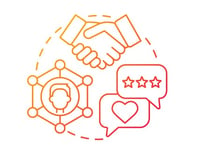 For example, brands like Nordstrom’s lavish benefits on those in the upper tiers, including a personal stylist who will shop with you in the store, or even do an in-home closet consultation. Other benefits include free dining/spa experiences and invite-only events. This is a great fit for brands that have front line staff who can deliver on this kind of differentiated experience, and it creates a strong aspirational value for the rank-and-file members to qualify for the next tier. Read more about Nordstrom's Nordy Club here.
For example, brands like Nordstrom’s lavish benefits on those in the upper tiers, including a personal stylist who will shop with you in the store, or even do an in-home closet consultation. Other benefits include free dining/spa experiences and invite-only events. This is a great fit for brands that have front line staff who can deliver on this kind of differentiated experience, and it creates a strong aspirational value for the rank-and-file members to qualify for the next tier. Read more about Nordstrom's Nordy Club here.
When structured correctly, Gamification Loyalty Programs maximize engagement and build strong loyalty sentiment at the same time. The best designs propel the customer on a journey across different products/experiences and create true participation in the brand. Game actions may include viewing content, adding content, engaging with interactive experiences, visiting a physical location, making a purchase or a near infinite array of other things.
![]() An extreme example of Gamification Loyalty Programs is Google Local Guides. Boasting more than 150MM members, this program is responsible for over 70% of the content displayed on Google Maps. With a series of badges for activities like adding reviews, creating places, and adding pictures, members earn higher levels of recognition. There are no tangible rewards for all of this activity; instead members are recognized at various levels of activity (e.g. adding 500 pictures). Tapping into the unique passions that your customers have and activating that with Gamification will produce results that are massively disproportionate to the investment.
An extreme example of Gamification Loyalty Programs is Google Local Guides. Boasting more than 150MM members, this program is responsible for over 70% of the content displayed on Google Maps. With a series of badges for activities like adding reviews, creating places, and adding pictures, members earn higher levels of recognition. There are no tangible rewards for all of this activity; instead members are recognized at various levels of activity (e.g. adding 500 pictures). Tapping into the unique passions that your customers have and activating that with Gamification will produce results that are massively disproportionate to the investment.
To help think about the loyalty playing field at a higher level we created a map, arraying each of these 7 options based on the level of engagement they generate, as well as the degree to which they can build loyalty sentiment / emotional loyalty. While each of these programs is designed to drive member behavior, they affect engagement and loyalty in varying ways:
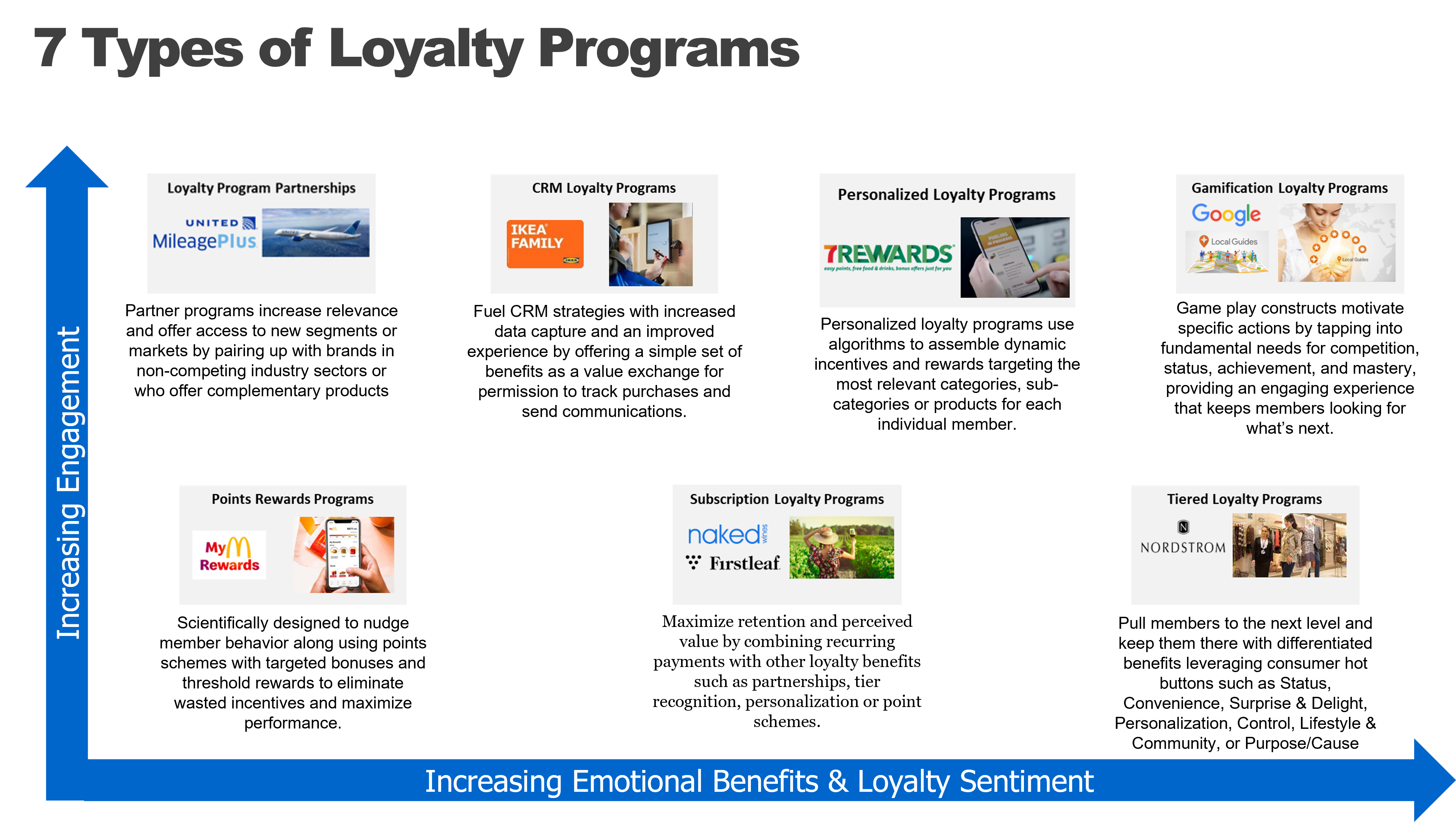 Determining the sweet spot for your brand will depend on your analysis and assessment of the current situation. For example, if you lack the means to engage customers between purchases, then this may guide your design in that direction. On the other hand, if you are seeing high degrees of unexpected attrition, it will be worth looking into program elements that can boost loyalty sentiment.
Determining the sweet spot for your brand will depend on your analysis and assessment of the current situation. For example, if you lack the means to engage customers between purchases, then this may guide your design in that direction. On the other hand, if you are seeing high degrees of unexpected attrition, it will be worth looking into program elements that can boost loyalty sentiment.
Please Contact Us for a complimentary consultation regarding the unique opportunities for your brand to build increased profit, engagement and loyalty.
Google Local Guides may not come to mind as a Gamification Loyalty Program, in fact most consumers aren’t even...
The online travel agent (OTA) space is highly competitive, and undergoing consolidation down to two key players:...
Comments